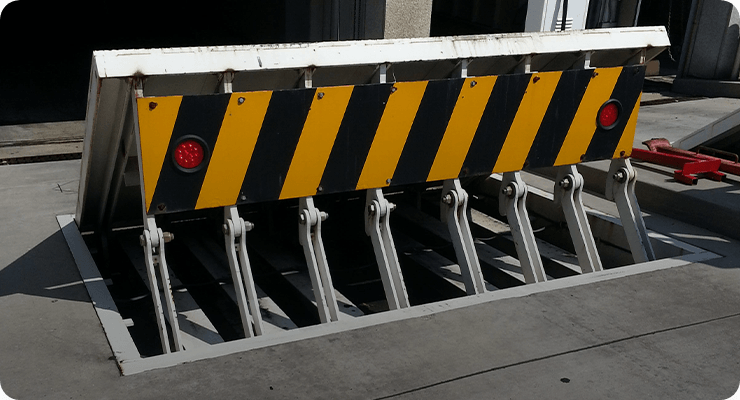Things about Wedge Barriers
Table of ContentsSome Ideas on Wedge Barriers You Need To Know3 Simple Techniques For Wedge Barriers

The 4-Minute Rule for Wedge Barriers
The staying force applied to
the cam camera deploy the wedge plate 16 may be provided offered an electromechanical actuator 84 or other actuator. The spring assembly 54 and the actuator 84(e. Wedge Barriers. g., electromechanical actuator)might run with each other to equate the webcam and raise the wedge plate 16.
As pointed out above, the springtime setting up 54 puts in a continuous force on the cam, while the electromechanical actuator may be regulated to exert a variable pressure on the webcam, consequently allowing the training and lowering( i. e., releasing and pulling back )of the wedge plate 16. In specific embodiments, the continuous pressure used by the spring setting up 54 may be flexible. g., electromechanical actuator) is disabled. As will certainly be appreciated, the spring assembly 54 might be covered and safeguarded from debris or various other elements by a cover plate(e. g., cover plate 68 shown in FIG. 4) that might be substantially flush with the elevated surface 38 of the foundation 14. As mentioned over, in the released setting, the wedge plate 16 serves to block access or traveling beyond the obstacle 10. For instance, the obstacle 10(e. g., the wedge plate 16 )might block pedestrians or cars from accessing a residential or commercial property or pathway. As reviewed over, the barrier 10 is affixed to the anchor 30 protected within the foundation 14,

front braces 71. As an outcome, the link settings up 72 might pivot and revolve to allow the collapse and expansion of the affiliation settings up 72 throughout retraction and deployment of the bather 10. The link assemblies 72 reason motion of the wedge plate 16 to be restricted. If a car is traveling towards the released wedge plate 16(e. For instance, in one scenario, the safety and security legs 86 might be prolonged throughoutmaintenance of the barrier 10. When the security legs 86 are deployed, the security legs 86 sustain the weight of the wedge plate 16 versus the surface 12. As a result, the training device 50 might be shut off, serviced, gotten rid of, replaced, and so forth. FIG. 5 is partial viewpoint sight of an embodiment of the surface-mounted wedge-style barrier 10, showing the webcam 80 and the cam surfaces 82 of the lifting system 50. Specifically, 2 webcam surface areas 82, which are described as reduced camera surfaces 83, are positioned below the webcam 80. The reduced web cam surfaces 83 might be taken care of to the surface area 12 (e. For example, the lower camera surface areas 83 and the placing plate 85 may form a solitary piece that is secured to the support 30 find out here by screws or various other mechanical bolts. Furthermore, 2 camera surfaces 82, which are described as upper web cam surfaces 87, are placed above the cam 80 wikipedia reference and combined to (e. In other personifications, stepping in layers or plates may be positioned between the surface area 12 and the lower cam surface areas 83 and/or the wedge plate 16 and the upper web cam surfaces 87 As stated over, the cam
80 translates along the web cam surface areas 82 when the wedge plate 16 is lifted from the retracted setting to the deployed placement. In addition, as pointed out above, the spring setting up 54 (see FIG. 3 )may provide a pressure acting on the camera 80 in the instructions 102 via springtime pole 58, which may decrease the force the electromechanical actuator 84 is required to put on the camera 80 in order to activate and raise the wedge plate 16. 1 )to the deployed placement(see FIG. 4). As revealed, the web cam 80 consists of track wheels 104(e. g., rollers), which call and translate along the web cam surfaces 82 throughout procedure.